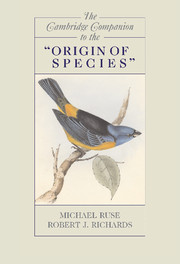Book contents
- Frontmatter
- Foreword
- Introduction
- 1 The Origin of the Origin
- 2 Darwin’s Analogy between Artificial and Natural Selection in the Origin of Species
- 3 Variation and Inheritance
- 4 Darwin’s Theory of Natural Selection and Its Moral Purpose
- 5 Originating Species: Darwin on the Species Problem
- 6 Darwin’s Keystone: The Principle of Divergence
- 7 Darwin’s Difficulties
- 8 Darwin’s Geology and Perspective on the Fossil Record
- 9 Geographical Distribution in the Origin of Species
- 10 Classification in Darwin’s Origin
- 11 Embryology and Morphology
- 12 Darwin’s Botany in the Origin of Species
- 13 The Rhetoric of the Origin of Species
- 14 “Laws impressed on matter by the Creator”? The Origin and the Question of Religion
- 15 Lineal Descendants: The Origin’s Literary Progeny
- 16 The Origin and Political Thought: From Liberalism to Marxism
- 17 The Origin and Philosophy
- 18 The Origin of Species as a Book
- Bibliography
- Index
9 - Geographical Distribution in the Origin of Species
Published online by Cambridge University Press: 28 January 2009
- Frontmatter
- Foreword
- Introduction
- 1 The Origin of the Origin
- 2 Darwin’s Analogy between Artificial and Natural Selection in the Origin of Species
- 3 Variation and Inheritance
- 4 Darwin’s Theory of Natural Selection and Its Moral Purpose
- 5 Originating Species: Darwin on the Species Problem
- 6 Darwin’s Keystone: The Principle of Divergence
- 7 Darwin’s Difficulties
- 8 Darwin’s Geology and Perspective on the Fossil Record
- 9 Geographical Distribution in the Origin of Species
- 10 Classification in Darwin’s Origin
- 11 Embryology and Morphology
- 12 Darwin’s Botany in the Origin of Species
- 13 The Rhetoric of the Origin of Species
- 14 “Laws impressed on matter by the Creator”? The Origin and the Question of Religion
- 15 Lineal Descendants: The Origin’s Literary Progeny
- 16 The Origin and Political Thought: From Liberalism to Marxism
- 17 The Origin and Philosophy
- 18 The Origin of Species as a Book
- Bibliography
- Index
Summary
GEOGRAPHY AND ITS IMPLICATIONS
In 1845, Darwin wrote to Joseph Dalton Hooker predicting that he (Hooker) would soon be recognized as the first authority in Europe on “that grand subject, that almost key-stone of the laws of creation: Geographical Distribution.” Darwin had already included a substantial section on the topic in his “Essay ” of 1844 and would interact extensively with Hooker on the topic over the next decade and more. The Origin of Species itself contains two chapters on distribution, occupying sixty-four pages, or just over 13 percent of the text of the first edition. These two chapters would be modified on minor points in the subsequent editions, but would remain essentially intact, serving as one of the main lines of support for his theory. Since they include his discussion of the distribution of species on the Galápagos Islands, they represent a key link in the process by which the theory was developed and then presented to the public.
It has always been recognized that the study of how species are located around the globe, on both a small and a large scale, was a key line of evidence leading Darwin toward the theory of common descent. The idea that divergence from a common ancestor was generated by a process that adapted populations to changes in their local environments (physical or organic) would eventually serve as one of his most convincing arguments in favour of natural selection.
- Type
- Chapter
- Information
- The Cambridge Companion to the 'Origin of Species' , pp. 153 - 172Publisher: Cambridge University PressPrint publication year: 2008
- 14
- Cited by



